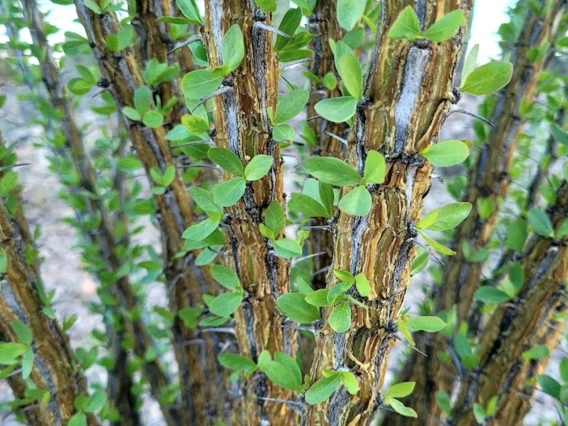Family: Fouquieriaceae
Compound: Fou spl
Synonyms: None
Geographic Origin: Southeastern US, south into central MX
Characteristics: A large, spiny shrub that grows to 6m (20ft) tall and about half as wide. It produces many straight stems from a woody base. Young bark is smooth, waxy and grey, turning furrowed and rough with age and exposing green patches beneath. Small, 5cm (2in) long obovate leaves grow bundled around the stem in an alternate and helical pattern in response to precipitation. The leaves take 2-3 weeks to mature before they abscise, leaving the remains of the petiole (leaf stalk) to harden into a sharp, 1.3-2.5cm (0.5-1in) spine which remains on the plant for the rest of its life. Leaves will drop and regrow 4 - 5 times a year from buds at the base of the spine. Bright red-orange tubular flowers are borne on panicles at the tip of the stems before leaves appear in the spring. When pollinated, flowers bear capsules that release many winged seeds. The plant also produces a thick tap root that can penetrate caliche and anchor the plant, along with several lateral roots that grow close to the surface of the soil to take advantage of precipitation.
Natural History: Prefers dry, rocky slopes and sandy flats below 5,000ft. This plant can drop and regrow its leaves man times each year to take advantage of rain without while conserving water during dry periods. It also has a waxy coating to aid in water retention. Flowers are primarily hummingbird pollinated. Seeds are wind distributed and mature in time to germinate during the monsoon season.
Cultivation Notes: Seeds remain highly viable (>90%) within a week of dispersal even if temperatures on the soil surface exceed 100F. Seed viability is reduced quickly with age. Seed production is greatest after heavy winter rains but is usually asynchronous (sporadic) throughout the spring. Ocotillo can also be propagated from stem cuttings which can root, but may not grow new arms. Prefers full sun and well drained soils. Great for landscaping due to its unique and attractive appearance as well as its hardy nature.
For general plant propagation information, click here
Ethnobotany: Seeds are edible and were made into flour. Nectar was extracted and turned into candy. The flowers can be sucked on or soaked in water to make a sweet beverage. The resulting liquid is also used as a tonic and blood purifier. The branches are often used to make fences or shade structures. Dried and ground roots are used to treat wounds and reduce inflammation. Wax from bark is used as a leather conditioner.
Citations:
Duffield, Mary Rose., and Warren D. Jones. Plants For Dry Climates - How To Select, Grow And Enjoy. Lane Publishing Company, 1992. Retrieved June 28, 2024
US Forest Service. Retrieved June 28, 2024
Virginia Tech Dendrology. Retrieved June 28, 2024







